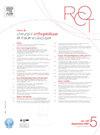La vancomycine topique utilisée au cours des prothèses de hanche ou de genou de première intention a-t-elle un effet protecteur vis-à-vis de la survenue d’infection ?
Q4 Medicine
Revue de Chirurgie Orthopedique et Traumatologique
Pub Date : 2024-10-28
DOI:10.1016/j.rcot.2024.09.001
引用次数: 0
Abstract
Introduction
L’infection est l’une des principales complications des prothèses de hanche et de genou. Le recours à la vancomycine topique en prévention des infections postopératoires, qui a montré son efficacité en chirurgie du rachis notamment, se répand en chirurgie prothétique. Son utilité et sa sécurité restent cependant débattus. Aussi, nous avons mené une étude rétrospective avec pour objectifs : (1) d’évaluer si la vancomycine topique diminuait le taux d’infections péri-prothétiques ; (2) étudier son influence sur d’éventuelles complications cicatricielles.
Hypothèse
Notre hypothèse était que l’ajout de vancomycine topique diluée peropératoire réduirait le taux d’infection lors de la première année postopératoire.
Matériel et méthodes
Au total, 1900 prothèses de hanche et de genou ont été posées entre 2014 et 2021 dans un centre hospitalier. Neuf cent-dix prothèses ont reçu de la vancomycine en instillation intra-articulaire avec de l’acide tranexamique entre juillet 2018 et décembre 2021 et 990 mises en place entre novembre 2014 et juin 2018 n’ont pas reçu de vancomycine. Le suivi, sur 12 mois minimum, cherchait une infection péri-prothétique dans l’année postopératoire ou des complications générales et cutanées de la vancomycine.
Résultats
Dans le groupe contrôle, 9/990 (0,91 %) se sont compliquées d’infection péri-prothétique comparés à 10/910 (1,1 %) prothèses dans le groupe vancomycine (p = 0,82). Dans le groupe contrôle, on observait 19/990 (1,9 %) complications cicatricielles regroupant érythème, sérum, hématome, désunion et retard de cicatrisation, contre 10/910 (1,1 %) dans le groupe traité (p = 0,19). Il n’y a pas eu de complications générales liées à l’utilisation de vancomycine.
Discussion
La vancomycine topique diluée ne permet pas de réduire le risque d’infection péri-prothétique. Son usage local n’entraîne pas plus de complications cicatricielles. À la vue de cette étude son utilisation en pratique courante ne peut pour l’heure être recommandée pour la prévention de l’infection sur les prothèses de hanche et de genou. Son utilisation n’est pas grevée de complications spécifiques (locales cicatricielles ou générales liées à l’ototoxicité ou néphrotoxicité).
Niveau de preuve
III ; étude cas témoin.
Background
Infection is one of the main complications of hip and knee arthroplasties. Topical application vancomycin to prevent postoperative infections is efficient in spine surgery, and is spreading in prosthetic surgery. However, its clinical relevance and safety are still under debate. Thus, we conducted the present study to (1) assess whether topical vancomycin reduces peri-prosthetic infection rate, and (2) investigate its influence on surgical wound complications.
Hypothesis
Our hypothesis was that topical administration of diluted vancomycin during arthroplasty would reduce infection rate within the first postoperative year.
Material and methods
In total, 1900 hip and knee arthroplasties were performed between 2014 and 2021 in a single hospital. From July 2018 and December 2021, 910 prostheses were implanted with intra-articular instillation of vancomycin and tranexamic acid. From November 2014 to June 2018, 990 prostheses were set up without vancomycin. During a follow-up of minimum 12 months, we reported periprosthetic infections occurring during the first postoperative year, as well as vancomycin-induced general or cutaneous complications.
Results
We observed periprosthetic infections in 9/990 cases (0.91%) of the control group and 10/910 cases (1.1%) of the vancomycin group (P = 0.82). In parallel, we observed wound complications (erythema, seroma, hematoma, dehiscence and delay in wound healing) in 19/990 (1.9%) and 10/910 cases (1.1%) of the control and vancomycin group, respectively (P = 0.19). There were no general complications resulting from the application of vancomycin.
Discussion
Topical diluted vancomycin does not reduce periprosthetic infection risk, and has no effect on the occurrence of surgery wound complications. Considering the present findings, the use of vancomycin cannot be recommended in current practice to prevent infections following hip and knee arthroplasties. Finally, its use does not induce any specific complications, whether local (cicatrization) or general (related to ototoxicity or nephrotoxicity).
Level of evidence
III; case control study.
在髋关节或膝关节置换手术中使用的外用万古霉素对感染有保护作用吗?
感染是髋关节和膝关节假体的主要并发症之一。局部万古霉素在预防术后感染方面的应用,特别是在脊柱手术中已被证明是有效的,现在正越来越多地用于修复手术。然而,它的有效性和安全性仍有争议。此外,我们还进行了回顾性研究,目的是:(1)评估外用万古霉素是否降低了假体周围感染率;(2)研究其对可能的疤痕并发症的影响。假设我们的假设是,术后第一年添加稀释的局部万古霉素可以降低感染率。2014年至2021年,一家医院共安装了1900个髋关节和膝关节假体。2018年7月至2021年12月期间,有190例关节内注射万古霉素,2014年11月至2018年6月期间,有990例关节内注射万古霉素未接受万古霉素。随访至少12个月,寻找术后一年内假体周围感染或万古霉素的一般和皮肤并发症。结果在对照组,9/990(0.91%)出现假体周感染并发症,而万古霉素组(p = 0.82)有10/910(1.1%)出现假体周感染并发症。在对照组中,19/990(1.9%)发生疤痕并发症,包括红斑、血清、血肿、不结合和疤痕形成延迟,而治疗组为10/910 (1.1%)(p = 0.19)。没有与使用万古霉素有关的一般并发症。稀释的局部万古霉素不能降低假体周围感染的风险。局部使用不会导致更多的疤痕并发症。根据这项研究,目前还不能推荐在日常实践中使用它来预防髋关节和膝关节假体感染。它的使用没有特定的并发症(疤痕或与耳毒性或肾毒性相关的一般局部)。证据等级III;案例研究。髋关节和膝关节置换术的主要并发症之一。万古霉素用于预防术后感染的外用应用在脊柱外科中是有效的,并在修复外科中广泛使用。然而,它的临床相关性和安全性仍有争议。因此,我们进行了目前的研究,以(1)评估外用万古霉素是否降低假体周围感染率,(2)调查其对手术伤口并发症的影响。我们的假设是,在关节成形术中局部给药稀释万古霉素将降低术后第一年的感染率。2014年至2021年,一家医院共进行了1900例髋关节和膝关节置换手术。截至2018年7月至2021年12月,共植入910个假体,进行万古霉素和转氨酸的关节内注射。从2014年11月到2018年6月,共安装了990个不含万古霉素的假体。在至少12个月的随访中,我们报告了术后第一年发生的假体周围感染,以及万古霉素诱导的一般或皮肤并发症。我们观察到对照组9/990例(0.91%)和万古霉素组10/910例(1.1%)的假体周感染(P = 0.82)。我们还观察了对照组和万古霉素组19/990(1.9%)和10/910例(1.1%)的伤口并发症(红斑、血清瘤、血肿、伤口愈合延迟)(P = 0.19)。使用万古霉素没有一般并发症。万古霉素不能降低假体周围感染的风险,对术后伤口并发症的发生没有影响。考虑到目前的研究结果,目前不建议使用万古霉素来预防髋关节和膝关节置换后的感染。最后,它的使用不会引起任何特定的并发症,无论是局部的(愈合)或一般的(与耳毒性或肾毒性有关)。证据等级III;案例控制研究。
本文章由计算机程序翻译,如有差异,请以英文原文为准。
求助全文
约1分钟内获得全文
求助全文
来源期刊

Revue de Chirurgie Orthopedique et Traumatologique
Medicine-Surgery
CiteScore
0.10
自引率
0.00%
发文量
301
期刊介绍:
A 118 ans, la Revue de Chirurgie orthopédique franchit, en 2009, une étape décisive dans son développement afin de renforcer la diffusion et la notoriété des publications francophones auprès des praticiens et chercheurs non-francophones. Les auteurs ayant leurs racines dans la francophonie trouveront ainsi une chance supplémentaire de voir reconnus les qualités et le intérêt de leurs recherches par le plus grand nombre.
 求助内容:
求助内容: 应助结果提醒方式:
应助结果提醒方式:


